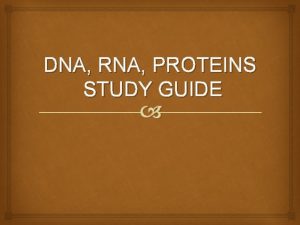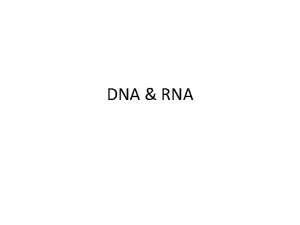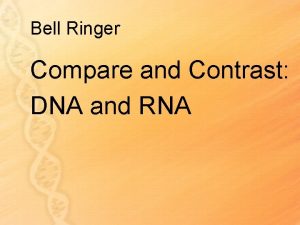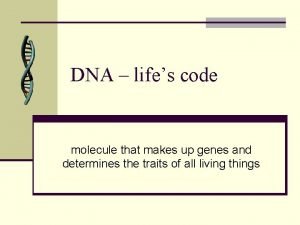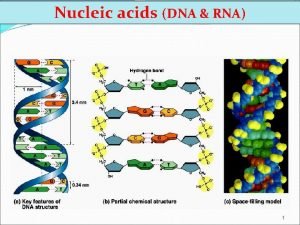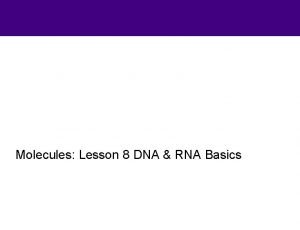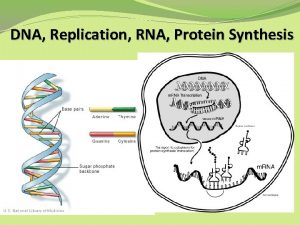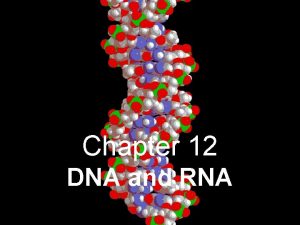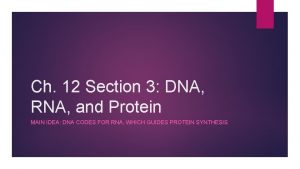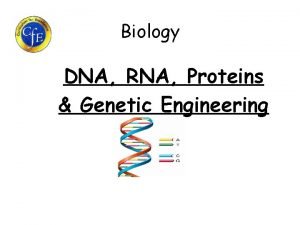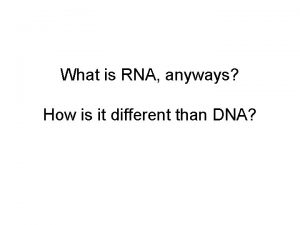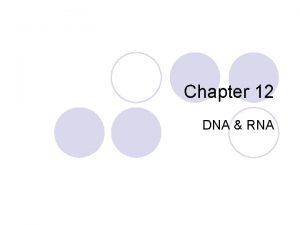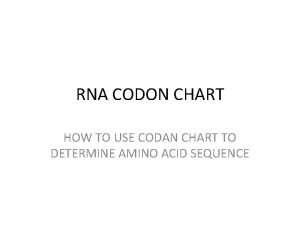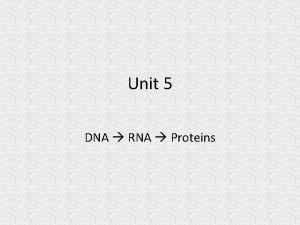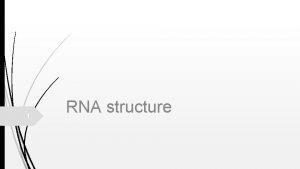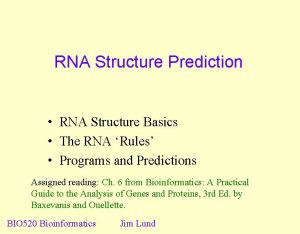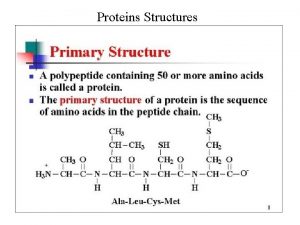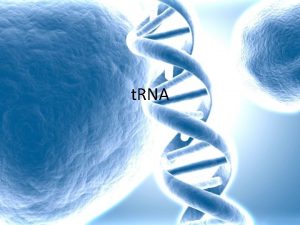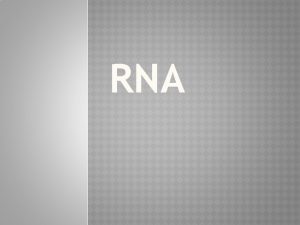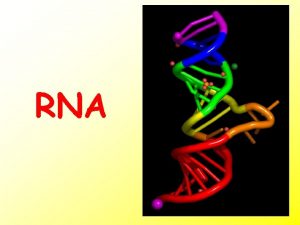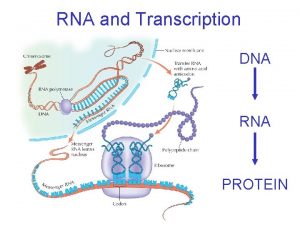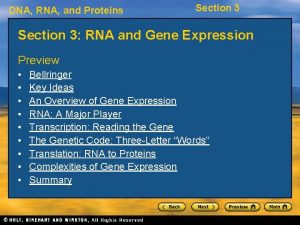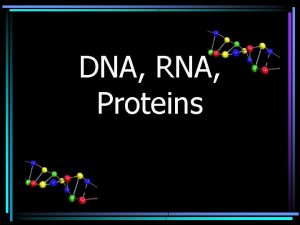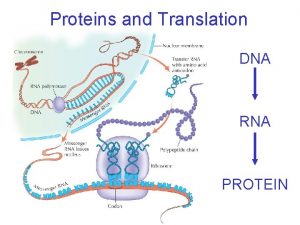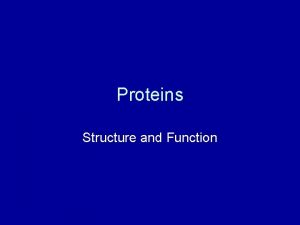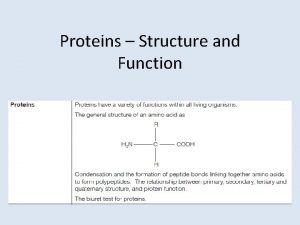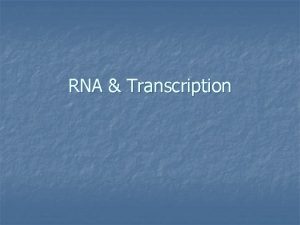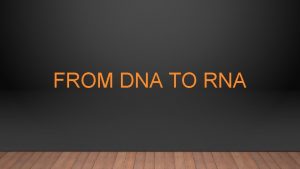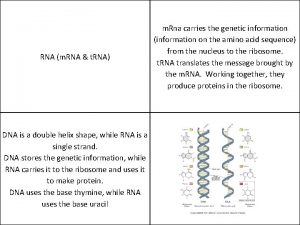DNA RNA and Proteins The Structure of DNA



















- Slides: 19

DNA, RNA and Proteins The Structure of DNA Ms. Yard

Learning Objectives • The students will be able to identify the substance that makes up genetic material. • The students will be able to name the experiments that led to the discovery of DNA’s structure and the experiments that identified the role of DNA. • The students will be able to relate the structure of DNA to the function of DNA as a carrier of information. • The students will be able to complete a model by creating a replica of DNA and labeling all of the components. • The student will be able to relate the importance of the discovery of DNA to how it has affected their life.

Why does it matter to you? • DNA is the “blueprint” from which all living things are made, so understanding DNA is key to understanding life.

DNA: The Genetic Material • 1800 s, Gregor Mendel showed that traits are passed from parents to offspring. • Many years later, scientists have discovered how these traits are passed on. – The instructions for inherited traits are called genes. • 1950 s, however, scientists did not know what genes were made of. • We now know that genes are made of small segments of deoxyribonucleic acid, or DNA • DNA is the primary material that causes recognizable, inheritable characteristics in related groups of organisms.

Griffith’s Discovery of Transformation • 2 separate strains of bacteria – S Strain- caused pneumonia, covered by a capsule of polysaccharides • Mice that were injected with the S Strain died • Mice that were inject with heat-killed S bacteria did not die but capsule was still present – R Strain-does not cause pneumonia and is not covered by capsule of polysaccharides • Mice injected with R bacteria did not die • Mice were injected with R bacteria and the heat-killed S bacteria did die – Why do you think that this happened?

Griffith’s Discovery of Transformation • Griffith had discovered transformation, which is a change in genotype that is caused when cells take up foreign genetic material. • His experiment led to the conclusion that genetic material could be transferred between cells. • But no one knew that this material was DNA.

Hershey-Chase Experiment The Hershey- Chase Experiment determined that DNA is the hereditary material, at least in viruses.

The Shape of DNA • After the 1950’s most scientists were convinced that genes were made of DNA, but nothing was known about it’s structure. • James Watson and Francis Crick pieced together a model of DNA’s structure • Structure – Winding Staircase – Nucleotide Subunits

The Shape of DNA • How were James Watson and Francis Crick able to determine the doublehelical structure of DNA? -Experiments from Chargaff, Wilkins and Franklin • Chargaff- 1949 - A=T and G=C -Using technology • Franklin and Wilkins- 1952 - high quality X-rays to study the structure of molecules

The Shape of DNA • A DNA molecule is shaped like a spiral staircase and is composed of two parallel strands of linked subunits. This spiral shape is known as a double helix. • Each nucleotide is made up of three parts 1. Phosphate group 2. Five –carbon sugar molecule 3. Nitrogen-Containing base.

The Shape of DNA

The Information in DNA • The structure of DNA is very important in the transfer of genetic information. • The information in DNA is contained in the order of the bases • Base-pairing structure allows the information to be copied • Each nucleotide has the same sugar molecule and phosphate group, but the nucleotide can have one of four nitrogenous bases – Nitrogenous Bases • Adenine (A) *A and G = purines • Guanine (G) • Thymine (T) *T and C= pyrimidines • Cytosine (C)

The Information in DNA • Base-Pairing Rules • A purine on one strand of a DNA molecule is always paired with a pyrimidine on the other strand. • Pyrimidines= Thymine (T) and Cytosine (C) • Purines= Adenine (A) and Guanine (G) • Adenine always pairs with thymine • Guanine always pairs with cytosine • dictated by the chemical structure of the bases

The Information in DNA • Paired bases are said to be complementary because they fit together • Example: TATGAGAGT • Example: TATGAGAGT ATACTCTCA Pairing insures that each strand of a DNA molecule contains the same information

The Information in DNA

Back to your DNA candy model… • Using your candy DNA model, make adjustments to your DNA. Remember to look back at your notes to determine any necessary changes.

4 -Corners Adenine Cytosine Thymine Guanine

4 Corners Adenine Thymine Cytosine Guanine • 4 - Corners asking the following questions: What is the missing complementary base nucleotide for each of the following? ATCG – What nitrogenous base is considered a purine? • Guanine AND adenine – What nitrogenous base is considered a pyrimidine? • Thymine and cytosine – In the sequence of nitrogenous bases in one strand of DNA is G A G T C, what is the bases in the underlined complementary strand of DNA? Answer: C T C A G

In the Future… • Replication of DNA – Describing the steps of DNA replication – Comparing the role of DNA helicases and DNA polymerases – Comparing the process of DNA replication in prokaryotes and in eukaryotes
 Dna rna and proteins study guide answers
Dna rna and proteins study guide answers Dna and genes chapter 11
Dna and genes chapter 11 Frederick griffith transformation
Frederick griffith transformation Rna transfer
Rna transfer Contrast between dna and rna
Contrast between dna and rna Dna and rna concept map
Dna and rna concept map Acids and bases venn diagram
Acids and bases venn diagram Dna and rna coloring worksheet
Dna and rna coloring worksheet Rna types
Rna types Phosphodiester bond
Phosphodiester bond Rnabases
Rnabases Fraction
Fraction Dna and rna
Dna and rna Chapter 12 dna and rna
Chapter 12 dna and rna Chapter 12 section 3 dna rna and protein
Chapter 12 section 3 dna rna and protein Dna protein synthesis study guide answers
Dna protein synthesis study guide answers Dna and rna
Dna and rna Nucleotide in rna
Nucleotide in rna A _________bond joins amino acids together.
A _________bond joins amino acids together. Rna codon chart
Rna codon chart
